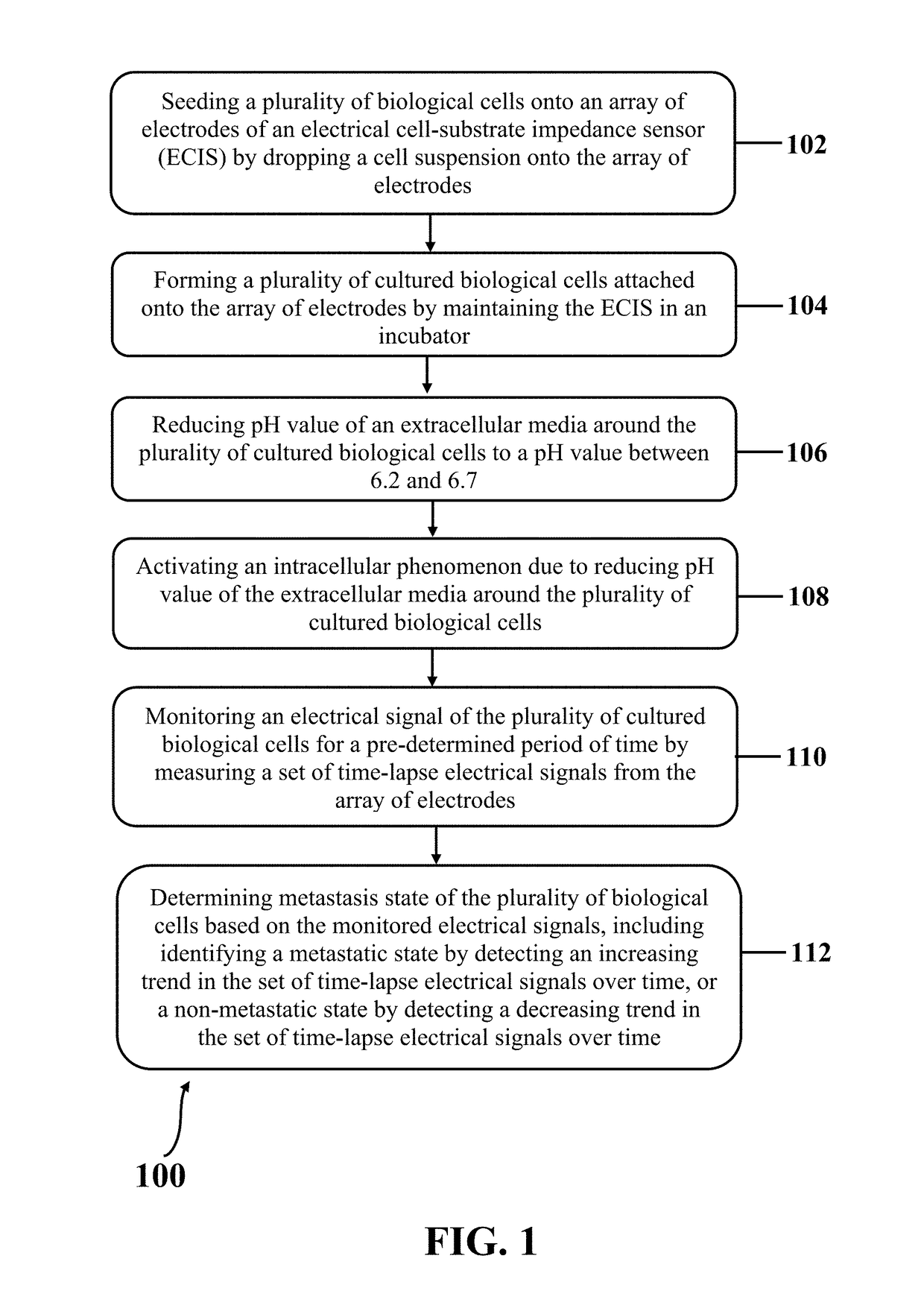METASTATIC CANCER DIAGNOSIS VIA DETECTING pH-DEPENDENT ACTIVATION OF AUTOPHAGY IN INVASIVE CANCER CELLS
- Summary
- Abstract
- Description
- Claims
- Application Information
AI Technical Summary
Benefits of technology
Problems solved by technology
Method used
Image
Examples
example 1
on of SiNWs Impedance Sensor (SiNW-ECIS)
[0086]In this example, exemplary ECISs with SiNWs electrodes array (SiNW-ECIS) similar to exemplary ECIS 200 were fabricated. Silicon wafers, which were used as substrates, were cleaned through standard RCA#1 cleaning method (NH4OH:H2O2:H2O solution and volume ratio of 1:1:5, respectively). Subsequently, a thin layer of SiO2 with a thickness of about 300 nm was grown on the substrate by wet oxidation furnace. A thin layer of gold (Au) with a thickness of about 10 nm was coated on SiO2 layer by a sputtering system at a pressure of about 20 mTorr as a catalyst layer. The gold layer was patterned and the design of the sensor transferred to the substrate. Au-covered samples were located in a low pressure chemical vapor deposition (LPCVD) system with a quartz tube chamber. The growth of silicon nanowires (SiNWs) was a two-step process named as graining and growth. During the graining, a thermal annealing at 450° C.-550° C. for about 30 minutes at t...
example 2
ure and Seeding
[0088]In this example, normal cell line (MCF10 non-cancerous breast epithelial cell line), primary cancerous cell line (MCF7 human breast cancer cell line), and metastatic cell line (MDA-MB-468 human breast cancer cell line) were obtained from a standard cell bank, which were isolated from normal sites, grades I and IV of human breast tumors, respectively. The cell lines were held at about 37° C. in an incubator (about 5% CO2, about 95% air) in RPMI-1640 medium supplemented with about 5% fetal bovine serum, and about 1% penicillin / streptomycin for MCF7 and MDA-MB468 cells and in DMEM-F12 supplemented with about 10% horse serum, about 1% antibiotic / antimitotic solution, about 0.2% NaHCO3, insulin (about 5 μg / ml), EGF (about 10 ng / ml) and hydrocortisone (about 1 μg / ml) for MCF10 cells. The fresh medium was replaced every other day. Standard cell culture methods were used for cell propagation. The cells were counted and suspended in about 100 μl of respective culture med...
example 3
ent Electrical Impedance of the Cells Measured by SiNW-ECIS
[0093]In this example, the electrical impedances of normal and malignant cells attached onto the SiNWs of exemplary fabricated SiNW-ECIS were measured by an exemplary impedance meter board similar to electrical readout board 304 that was designed and prepared in-house for impedance measurement purposes. Exemplary Impedance meter board was connected through coaxial wires to exemplary SiNW-ECIS including the attached normal and malignant cells onto the SiNWs. Measurements were performed with an applied voltage of about 200 mV. The real time measurements of cellular bioelectrical functions were recorded at desired frequencies (about 0.4 kHz-400 kHz) in the known interval of times. DMEM (including Na+, K+, Mg2+, Ca2+ and etc. ions and amino acid, glucose and etc. buffers) was used as cells' carrier solution. The pH was controlled by low concentrations of HCl with the assistance of a pH meter. The electrical responses (electrical...
PUM
 Login to View More
Login to View More Abstract
Description
Claims
Application Information
 Login to View More
Login to View More - R&D
- Intellectual Property
- Life Sciences
- Materials
- Tech Scout
- Unparalleled Data Quality
- Higher Quality Content
- 60% Fewer Hallucinations
Browse by: Latest US Patents, China's latest patents, Technical Efficacy Thesaurus, Application Domain, Technology Topic, Popular Technical Reports.
© 2025 PatSnap. All rights reserved.Legal|Privacy policy|Modern Slavery Act Transparency Statement|Sitemap|About US| Contact US: help@patsnap.com



